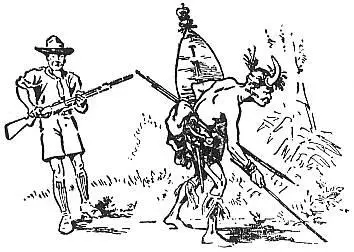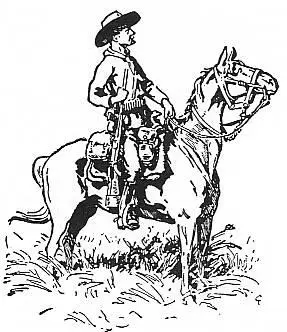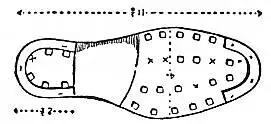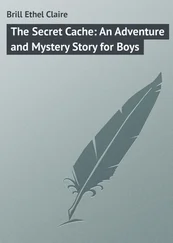Robert Robert - Scouting for Boys
Здесь есть возможность читать онлайн «Robert Robert - Scouting for Boys» весь текст электронной книги совершенно бесплатно (целиком полную версию без сокращений). В некоторых случаях можно слушать аудио, скачать через торрент в формате fb2 и присутствует краткое содержание. Жанр: Старинная литература, und. Описание произведения, (предисловие) а так же отзывы посетителей доступны на портале библиотеки ЛибКат.
- Название:Scouting for Boys
- Автор:
- Жанр:
- Год:неизвестен
- ISBN:нет данных
- Рейтинг книги:3 / 5. Голосов: 1
-
Избранное:Добавить в избранное
- Отзывы:
-
Ваша оценка:
- 60
- 1
- 2
- 3
- 4
- 5
Scouting for Boys: краткое содержание, описание и аннотация
Предлагаем к чтению аннотацию, описание, краткое содержание или предисловие (зависит от того, что написал сам автор книги «Scouting for Boys»). Если вы не нашли необходимую информацию о книге — напишите в комментариях, мы постараемся отыскать её.
Scouting for Boys — читать онлайн бесплатно полную книгу (весь текст) целиком
Ниже представлен текст книги, разбитый по страницам. Система сохранения места последней прочитанной страницы, позволяет с удобством читать онлайн бесплатно книгу «Scouting for Boys», без необходимости каждый раз заново искать на чём Вы остановились. Поставьте закладку, и сможете в любой момент перейти на страницу, на которой закончили чтение.
Интервал:
Закладка:
As soon as a “hunter” can get near enough to the “fugitive”, without being seen, to take down his number, the latter is caught. But if the “fugitive” can, by any means, turn the tables and get any of his pursuers’ numbers, the latter are out of action.
As soon as a number is taken down, the Scout who takes it must call it out, to let his captive know he is out of action.
This game necessitates some careful stalking. A sharp Scout in the Patrol should be chosen for the “fugitive”, as he has not only to elude perhaps six or seven pursuers, but he must also endeavour to “capture” them, unless he wishes to get killed himself.
CAMP FIRE YARN NO. 12
SPOORING
Men’s Tracks - Animals’ Tracks - The Age of Tracks
Hints on “Spooring”

GENERAL DODGE, OF THE AMERICAN ARMY, describes how he once had to pursue a party of Red Indians who had murdered some people.
The murderers had nearly a week’s start, and had gone away on horseback. Except for one, they were all riding unshod horses.
General Dodge got a splendid tracking-scout named Espinosa to help him. After tracking the Indians for many miles, Espinosa suddenly got off his horse and pulled four horseshoes out of a hidden crevice in the rocks. The rider of the shod horse had evidently pulled them off so that they should not leave a track.
For six days Dodge and his men pursued the band, and for a great part of the time there was no sign visible to an ordinary eye. After going for 150 miles they eventually overtook and captured the whole party. It was entirely due to Espinosa ~ good tracking.
Tracking by Night
On another occasion some American troops were following up a number of Indians, who had been raiding and murdering whites. They had some other Red Indian scouts to assist them in tracking.
In order to make a successful attack, the troops marched by night, and the trackers found the way in the darkness by feeling the tracks of the enemy with their fingers. They led on at a fairly good pace for many miles ; but suddenly they halted and reported that the track they had been following had been crossed by a fresh track. When the commanding officer came up, he found the Indians still holding the track with their hands, so that there should be no mistake.
A light was brought and it was found that the new track was that of a bear which had walked across the trail of the enemy! The march continued without further incident, and the enemy was surprised and caught in the early hours of the morning.
The American Scout, Frederick Burnham, who was with Wilson’s men in South Africa when they were massacred on the Shangani River in Matabeleland, was sent away with a dispatch shortly before they were surrounded. He travelled during the night to escape the observation of the enemy. He found his way by feeling for the tracks left in the mud by the column when it marched up there in the morning.
I myself led a column through an intricate part of the Matopo Mountains in Rhodesia by night to attack the enemy’s stronghold which I had reconnoitred the previous day. I found the way by feeling my own tracks, sometimes with my hands and sometimes through the soles of my shoes, which had worn very thin. I never had any difficulty in finding the line.
The Importance of Tracking
Tracking, or following up tracks, is called by different names in different countries Thus, in South Africa, you would talk only of “spooring”, that is, following up the “spoor”; in India, it would he following the “pugs”, or “pugging”; in North America, it is also called “trailing”.
It is one of the principal ways by which Scouts gain information and hunters find their game. But to become a good tracker you must begin young and practise it at all times when you are out walking, whether in town or country.
If at first you constantly remind yourself to do it, you will soon find that you do it as a habit without having to remind yourself. It is a very useful habit, and makes the dullest walk interesting.
Hunters when they are looking about in a country to find game first look for any tracks, old or new, to see if there are any animals in the country. Then they study the newer marks to find out where the animals are hiding themselves. Then, after they have found a fresh track, they follow it up till they find the animal and kill it. Afterwards they often have to retrace their own tracks to find their way back to camp. War scouts do much the same as regards their enemies.

Frederick Bur nham, American Scout, became famous in Matabeleland.
Men’s Tracks
First of all you must be able to distinguis h one man’s foot-mark from that of another, by its size, shape, and nails, etc. And, similarly, the prints of horses and other animals.
From a man’s track, that is, from the size of his foot and the length of his stride, you can tell, to a certain extent, his height.
In taking notes of a track you should pick out a well-marked print, very carefully measure its length, length of heel, width of sole, width at instep, width of heel, number of rows of nails, and number of nails in each row, heel and toe-plates or nails, shape of nail-heads, nails missing, etc.
It is best to make a diagram of the foot-print thus.
You should also measure very carefully the length of the man’s step from the heel of one foot to the heel of the other.
A man was once found drowned in a river. It was supposed that he must have fallen in accidentally, and that the cuts on
his head were caused by stones, etc., in the river. But someone
took a drawing of his boots, and after searching the river-bank came on his tracks, and followed them up to a spot where there had evidently been a struggle: The ground was much trampled and bushes broken down to the water’s edge, and there were tracks of two other men’s feet. Though these men were never found, it showed the case to be one of probable murder, which would not otherwise have been suspected.

Notice the length of the shoe, the width of
the sole, the length of the heel, as well as details. X indicates missing nails.
Differences Between Bare-Foot Tracks
It is very puzzling for a beginner to tell the difference between a lot of footmarks of bare feet—they all look so much alike—but this is the way that the Indian police trackers do it:
When measuring the footprint of the man you are after draw a line from the tip of the big toe to the tip of the little toe, and then notice where the other toes come with regard to this line, and put it down in your note-book. Then when you come to a number of tracks you have only to try this same line on one or two of them till you find the one you want. All people vary a little in the position of their toes.
Try it with the other Scouts in your Patrol, each of you making a footprint with his bare foot, and then noting how it is different from the others when the toe line is drawn.
The Pace of Tracks
A Scout must learn to recognize at a glance at what pace the maker of the tracks was going.
A man walking puts the whole flat of his foot on the ground, each foot a little under a yard from the other.
Читать дальшеИнтервал:
Закладка:
Похожие книги на «Scouting for Boys»
Представляем Вашему вниманию похожие книги на «Scouting for Boys» списком для выбора. Мы отобрали схожую по названию и смыслу литературу в надежде предоставить читателям больше вариантов отыскать новые, интересные, ещё непрочитанные произведения.
Обсуждение, отзывы о книге «Scouting for Boys» и просто собственные мнения читателей. Оставьте ваши комментарии, напишите, что Вы думаете о произведении, его смысле или главных героях. Укажите что конкретно понравилось, а что нет, и почему Вы так считаете.

![Роберт Баден-Пауэлл - Искусство скаута-разведчика[Scouting for boys ; Искусство Разведки для мальчиков]](/books/70572/robert-baden-pauell-iskusstvo-skauta-thumb.webp)









